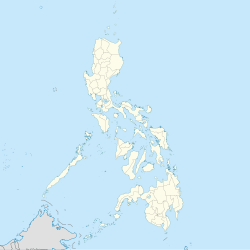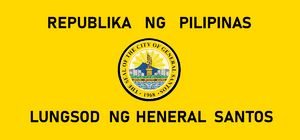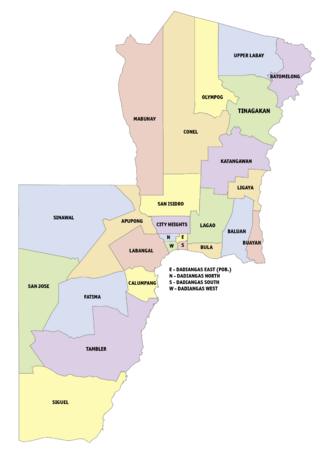General Santos facts for kids
Quick facts for kids
General Santos
|
|||
|---|---|---|---|
|
Highly urbanized city
|
|||
| City of General Santos | |||
| Other transcription(s) | |||
| • Jawi | جنرل سنتوس | ||
|
From top, left to right: Aerial view of urban GenSan, Robinsons Place GenSan, Dadiangas skyline, and Pioneer Avenue
|
|||
|
|||
| Nickname(s):
Tuna Capital of the Philippines
|
|||
| Anthem: Himno ng Heneral Santos (English: General Santos Hymn) |
|||

Map of South Cotabato with General Santos highlighted
|
|||
|
OpenStreetMap
|
|||
| Country | Philippines | ||
| Region | Soccsksargen | ||
| Province | South Cotabato (geographically only) | ||
| District | Lone district of General Santos | ||
| Founded |
|
||
| Renamed | June 15, 1954 (as General Santos) |
||
| Cityhood | July 8, 1968 | ||
| Highly urbanized city | September 5, 1988 | ||
| Named for | General Paulino Santos | ||
| Barangays | 26 (see Barangays) | ||
| Government
|
|||
| • Type | Sangguniang Panlungsod | ||
| Area | |||
| • Total | 492.86 km2 (190.29 sq mi) | ||
| Elevation | 197 m (646 ft) | ||
| Highest elevation | 869 m (2,851 ft) | ||
| Lowest elevation | 0 m (0 ft) | ||
| Population
(2020 census)
|
|||
| • Total | 697,315 | ||
| • Density | 1,414.834/km2 (3,664.40/sq mi) | ||
| • Households | 175,345 | ||
| Demonym(s) | Gensanon | ||
| Economy | |||
| • Gross domestic product (GDP) | ₱129.015 billion (2022) $2.279 billion (2022) |
||
| • Income class | 1st city income class | ||
| • Poverty incidence |
|
||
| • Revenue | ₱ 3,957 million (2022) | ||
| • Assets | ₱ 9,751 million (2022) | ||
| • Expenditure | ₱ 2,983 million (2022) | ||
| • Liabilities | ₱ 2,371 million (2022) | ||
| Service provider | |||
| • Electricity | South Cotabato 2 Electric Cooperative (SOCOTECO 2) | ||
| Time zone | UTC+8 (PST) | ||
| ZIP code |
9500
|
||
| PSGC |
[https://psa.gov.ph/classification/psgc/?q=psgc/barangays/{{#pro000®code={{&provcode=
|
||
| IDD : area code | +63 (0)83 | ||
| Native languages | Hiligaynon Cebuano Tboli Blaan Tagalog Maguindanaon |
||
| Website | www |
||
General Santos, often called GenSan, is a big city in the Soccsksargen region of the Philippines. It is known as the Tuna Capital of the Philippines because it's a major center for tuna fishing. In 2020, about 697,315 people lived there, making it the most populated city in its region.
GenSan is located on the island of Mindanao, in the southern part of the Philippines. It is a very important city for business and industry in the Soccsksargen region. Even though it's in South Cotabato province, it runs independently.
Contents
City Name: General Santos
The city is named after General Paulino Santos. He was a former leader of the Philippine Army and a key person in starting the settlement here.
History of General Santos
Early Settlers and Beginnings
The first people to live in the area of General Santos were the nomadic Blaan people. Many place names in the city come from their language. They called the area Dadiangas, after a type of tree that used to grow there. The Blaan people now live alongside newer settlers and other groups.
Later, Muslim groups settled in the area, and the Blaan people moved to the hills. The area became a port under the rule of the Sultanate of Buayan.
Spanish and American Times
In 1898, when Spanish rule in the Philippines ended, two brothers from Spain settled in Makar. This area is now called Brgy. Labangal. In 1903, the Municipality of Makar was officially created. Later, in 1914, the Municipal District of Buayan was also formed.
In 1939, General Paulino Santos led 62 Christian settlers from Luzon to Sarangani Bay. These pioneers were mostly farmers and traders. They came to develop the land. After them, many more people from other parts of the Philippines moved to the area.
In March 1939, the first official settlement was set up in Alagao, now called Barangay Lagao. This area became the independent Municipal District of Buayan in 1940.
World War II and City Growth
During World War II, the Municipal District of Buayan was a key defense area. Japanese forces built bunkers and tunnels there. Some of these bunkers can still be seen today.
After the war, in 1947, Buayan became a regular municipality. It included Makar and Glan. In 1954, the municipality was renamed General Santos to honor General Paulino Santos.
From 1963 to 1967, the city's economy grew a lot. Big farming and business companies like Dole Philippines started operating there. On July 8, 1968, General Santos officially became a city. Antonio C. Acharon became its first mayor. In 1988, GenSan was declared a "highly urbanized city." This meant it became independent from South Cotabato province.
In 2019, General Santos gained its own representative in the Philippine Congress. This separated it from South Cotabato's congressional district.
Geography of General Santos
General Santos is in the southern part of the Philippines, on the island of Mindanao. It is southeast of Manila and Cebu, and southwest of Davao.
The city is surrounded by other towns. To the east is Alabel, and to the south is Maasim, both in Sarangani Province. To the north are Polomolok (South Cotabato) and Malungon (Sarangani). To the west is T'boli. General Santos has the entire coastline of South Cotabato.
Climate in General Santos
| Climate data for General Santos (1991–2020, extremes 1949–2020) | |||||||||||||
|---|---|---|---|---|---|---|---|---|---|---|---|---|---|
| Month | Jan | Feb | Mar | Apr | May | Jun | Jul | Aug | Sep | Oct | Nov | Dec | Year |
| Record high °C (°F) | 37.5 (99.5) |
38.0 (100.4) |
38.9 (102.0) |
39.0 (102.2) |
39.4 (102.9) |
38.5 (101.3) |
37.0 (98.6) |
37.0 (98.6) |
36.5 (97.7) |
37.0 (98.6) |
37.0 (98.6) |
37.5 (99.5) |
39.0 (102.2) |
| Mean daily maximum °C (°F) | 32.3 (90.1) |
32.9 (91.2) |
34.0 (93.2) |
34.3 (93.7) |
33.5 (92.3) |
32.2 (90.0) |
31.7 (89.1) |
31.7 (89.1) |
32.2 (90.0) |
32.6 (90.7) |
32.8 (91.0) |
32.6 (90.7) |
32.7 (90.9) |
| Daily mean °C (°F) | 27.5 (81.5) |
27.9 (82.2) |
28.5 (83.3) |
28.9 (84.0) |
28.5 (83.3) |
27.7 (81.9) |
27.2 (81.0) |
27.3 (81.1) |
27.5 (81.5) |
27.7 (81.9) |
27.9 (82.2) |
27.8 (82.0) |
27.9 (82.2) |
| Mean daily minimum °C (°F) | 22.6 (72.7) |
22.8 (73.0) |
23.0 (73.4) |
23.5 (74.3) |
23.6 (74.5) |
23.1 (73.6) |
22.8 (73.0) |
22.8 (73.0) |
22.8 (73.0) |
22.8 (73.0) |
23.0 (73.4) |
23.0 (73.4) |
23.0 (73.4) |
| Record low °C (°F) | 17.1 (62.8) |
17.2 (63.0) |
16.9 (62.4) |
18.3 (64.9) |
18.7 (65.7) |
17.9 (64.2) |
17.2 (63.0) |
17.5 (63.5) |
18.0 (64.4) |
18.2 (64.8) |
18.3 (64.9) |
18.0 (64.4) |
16.9 (62.4) |
| Average rainfall mm (inches) | 96.9 (3.81) |
53.0 (2.09) |
55.3 (2.18) |
54.1 (2.13) |
72.2 (2.84) |
101.9 (4.01) |
98.1 (3.86) |
91.3 (3.59) |
83.3 (3.28) |
99.6 (3.92) |
77.5 (3.05) |
74.9 (2.95) |
958.1 (37.72) |
| Average rainy days (≥ 0.1 mm) | 9 | 7 | 6 | 6 | 8 | 12 | 11 | 11 | 10 | 10 | 8 | 8 | 106 |
| Average relative humidity (%) | 79 | 76 | 75 | 75 | 78 | 82 | 83 | 82 | 81 | 81 | 80 | 79 | 79 |
| Source: PAGASA | |||||||||||||
General Santos has a tropical wet and dry climate. This means it has both wet and dry seasons. It is one of the driest places in the Philippines, with less than 1000 mm of rain each year.
Barangays of General Santos
General Santos is divided into 26 smaller areas called barangays. Each barangay has even smaller parts called puroks or sitios.
- Apopong
- Baluan
- Batomelong
- Buayan
- Bula
- Calumpang
- City Heights
- Conel
- Dadiangas East
- Dadiangas North
- Dadiangas South
- Dadiangas West
- Fatima
- Katangawan
- Labangal
- Lagao (1st & 3rd)
- Ligaya
- Mabuhay
- Olympog
- San Isidro (Lagao 2nd)
- San Jose
- Siguel
- Sinawal
- Tambler
- Tinagacan
- Upper Labay
People of General Santos
The main languages spoken in General Santos are Cebuano and Hiligaynon. Cebuano is widely used, especially in local news. Hiligaynon is spoken by people who moved from nearby provinces. Other languages include Blaan, T'boli, and Maguindanaon.
Religions in General Santos
| Religion in General Santos (2020) | ||||
|---|---|---|---|---|
| Religion | percentage | |||
| Roman Catholic | 65% | |||
| Other Christian, including Protestants | 20.5% | |||
| Islam | 9.8% | |||
| Iglesia ni Cristo | 3.3% | |||
| Others | 1.4% | |||
Most people in General Santos are Christians, with the largest group being Roman Catholics. About 9% of the people follow Islam.
Economy of General Santos
| Source: Philippine Statistics Authority |
|
The economy of General Santos mainly relies on two areas: farming and fishing.
Farming and Agriculture
General Santos has rich volcanic soil and good rainfall all year. This makes it great for growing crops like corn, coconut, pineapple, asparagus, banana, and rice. The city also produces high-quality fruits, vegetables, and flowers. It is also a top producer of livestock like poultry, hogs, and cattle. However, as the city grows, some farmlands are being used for buildings and homes.
Fishing Industry
General Santos is the biggest producer of high-quality tuna in the Philippines. This is why it's called the "Tuna Capital of the Philippines." The city's fishing industry catches about 750 metric tons of fish every day and employs around 7,800 workers.
General Santos has seven tuna processing plants. The Fishport Complex in Barangay Tambler has modern facilities for handling fish. Locals are proud that their fish and seafood are very fresh.
In 2011, General Santos saw 1,365 new medium to large businesses open. These businesses brought in about PHP 1.202 billion in investments. Many new investments were in hotels, restaurants, and retail trade.
The city has many banks, lending institutions, and pawnshops. These help people and businesses with their money needs.
Shopping in General Santos
General Santos is a major shopping destination in the Soccsksargen region. People from nearby towns come to the city to shop and enjoy activities. There are several large shopping malls, including KCC Mall of Gensan, SM City General Santos, Robinsons Place GenSan, and Gaisano Mall of GenSan. These malls offer many local and international brands, restaurants, and cafes.
City Infrastructure
Communication Services
General Santos has modern communication services. Major companies provide phone, internet, and network solutions. These services are available through both wired connections and mobile networks.
Transportation in General Santos
You can reach General Santos by air, land, or sea.
Air Travel
The General Santos International Airport is the largest airport in Mindanao. It has a long concrete runway that can handle big airplanes. Airlines like Philippine Airlines and Cebu Pacific have flights to and from Manila, Iloilo, and Cebu. It is the second busiest airport in Mindanao.
Sea Travel
The Makar Wharf is the city's main international seaport. It is located in Barangay Labangal. The wharf is very long and can hold many ships at once. It has modern facilities for handling cargo. Several shipping companies offer regular trips to other major ports in the Philippines. Some Indonesian shipping lines also connect General Santos to ports in Indonesia.
Land Travel
Getting around General Santos by land is easy. Over 400 passenger buses, vans, and jeepneys travel within the city and to nearby provinces. Tricycles are the main public transport inside the city. Air-conditioned taxis are also available.
The city's main roads are well-maintained. The Pan-Philippine Highway connects General Santos to other major cities in Mindanao and the rest of the country. The General Santos Terminal, also known as Bulaong Terminal, is the main land transport hub. Buses from here go to various parts of Mindanao.
Utilities and Services
Power Supply
Most of the city's electricity is provided by the South Cotabato Electric Cooperative (SOCOTECO-II). They get power from the National Transmission Corporation and other power plants.
Water Supply
Most homes and businesses in General Santos get clean and safe drinking water from the General Santos City Water District (GSCWD). In remote areas, local water systems provide water.
Waste Management
The city is working on better ways to manage waste. A new wastewater treatment facility is being built near the public market. Also, a modern solid waste management and disposal system is being built in Barangay Sinawal. This new facility will replace the old city dumpsite.
Health Services
General Santos has 19 hospitals with over 2,200 beds. These include General Santos Doctors Hospital and St. Elizabeth Hospital. These hospitals provide medical care for the people of the city. A new hospital, ACE Medical Center, is also being built to add more beds and services.
Education in General Santos

General Santos has over 50 private schools and colleges, and more than 100 public schools. It is also home to three universities:
- Notre Dame of Dadiangas University
- Mindanao State University – General Santos City
- New Era University – General Santos Branch
The General Santos campus of the country's oldest university, University of Santo Tomas, opened in the school year 2024-2025.
Ramon Magsaysay Memorial Colleges
In 1957, Atty. Eugenio Millado and Doña Aurora Millado started Mindanao Vocational School (MVS). This school later became Ramon Magsaysay Memorial Colleges (RMMC). It is known for providing good and affordable education to students in the region. The Millado family's dedication has helped RMMC become an important part of education and community development in Mindanao.
Notre Dame of St. Therese of the Child Jesus
Notre Dame of St. Therese of the Child Jesus (NDST) is a private school. It offers primary education, junior high school, and senior high school. The school follows the K-12 education system in the Philippines. It is run by the Disciples of St. Therese of the Child Jesus (DST), a Catholic religious group. The school opened in 2001.
Media in General Santos
General Santos has several local newspapers like SusStar General Santos and Periodiko Banat. Brigada Newspaper General Santos is a very popular newspaper company in the city.
There are also many television and radio stations. Some TV stations include GMA 8 Soccsksargen and TV5 Channel 12 Gensan. These stations reach many areas in the Soccsksargen Region. Many FM and AM radio stations operate 24 hours a day, such as 89.5 Brigada News FM and iFM 91.9.
Local news programs in General Santos include GMA Soccsksargen Flash Bulletin and Ronda Brigada.
Famous People from General Santos
- Sebastian Benedict (Baeby Baste), child actor
- Gerald Anderson, actor
- Melai Cantiveros-Francisco, actress and host
- Nonito Donaire, professional boxer
- Manny Pacquiao, professional boxer and politician
- Shamcey Supsup, Miss Universe 2011 3rd Runner-up
- Zendee Rose Tenerefe, singer and YouTube personality
- XB Gensan, dance group
Sister Cities
Local Sister Cities
- Naga, Camarines Sur
- Quezon City
- Iloilo City
- Cotabato City
International Sister Cities
 Canberra, Australia
Canberra, Australia Jersey City, USA
Jersey City, USA Monterrey, Mexico
Monterrey, Mexico Hadano, Kanagawa, Japan
Hadano, Kanagawa, Japan
Images for kids
See also
 In Spanish: General Santos para niños
In Spanish: General Santos para niños
- List of renamed cities and municipalities of the Philippines




















